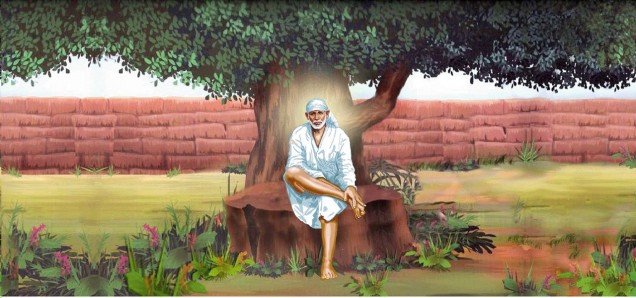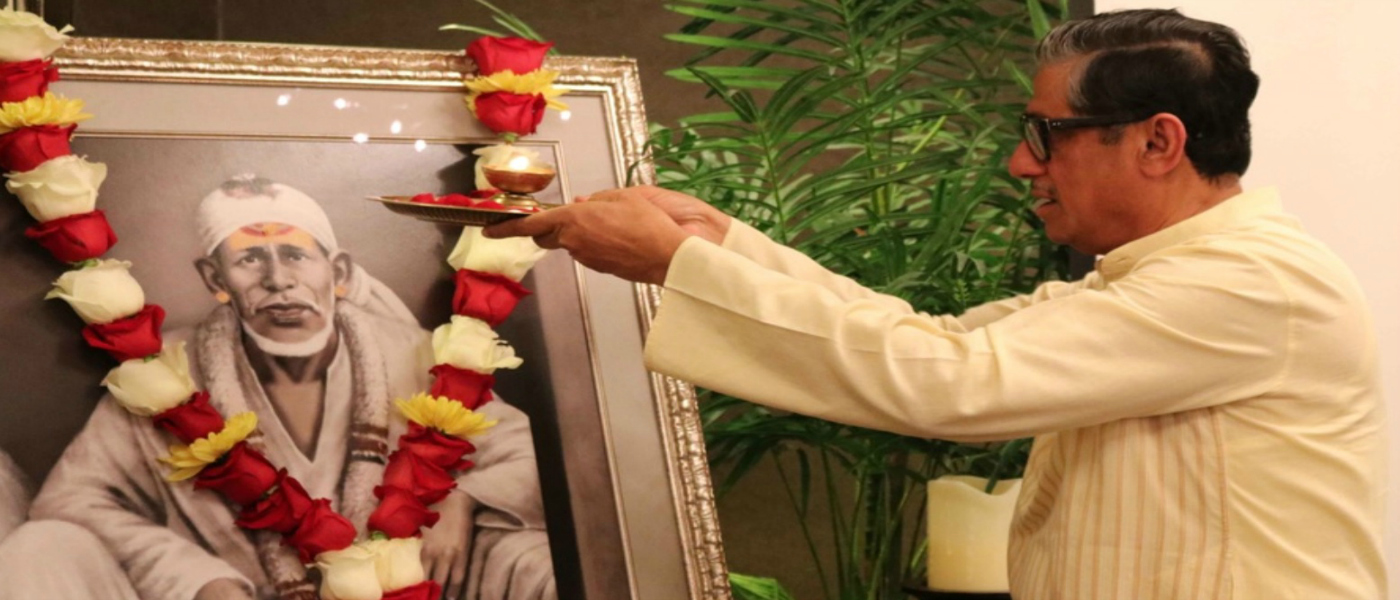Significance of the Neem Tree
Shri Sai Baba was first seen in Shirdi sitting under the Neem tree when he was just 16 years old. The people of the village were wonder-struck to see such a young lad practicing hard penance, not minding heat and cold. He went to nobody’s door, but always sat near the neem tree. Young ‘Sai Baba’ (even this title was not conferred on him by that time) stayed under the neem tree for about three years but suddenly left Shirdi. No one knew where he went or why. After a year or so, he again returned to Shirdi and stayed on there till his mahasamadhi in 1918 i.e., for sixty years. Baba told the villagers that under the Neem tree was His Guru’s Samadhi (shrine).

Even after his second advent at Shirdi, Sai baba seemed to have lived under the neem tree for some time and a particular incident was responsible for Baba’s changing his residence to the old dilapidated mosque in the village. The details of the incidents are as follows:
Once there were very heavy rains at Shirdi and a large portion of it was flooded. After a long while some of his very early devotees remembered the homeless fakir and wanted to see where he took shelter from the rain. Mahalsapathy and a few others rushed to the margosa tree and were stunned to see that Sai Baba was there under the same tree, half-reclining, in a state of samadhi. Water flowed all over him. All the rubbish and filth gathered over his body. They dared not wake him up from that state. A few hours later, when the water had drained away, they returned to see him still lying on the damp earth; his body and face were completely covered with mud deposited by the receding water. They felt guilty at their gross neglect of Baba’s welfare when he was their sole protector and guide. Later, when Baba returned to consciousness, these devotees persuaded him to take shelter in the small, dilapidated mud-built mosque in the village.
Baba always used to sit under the neem tree. In most religions, the tree symbolizes the whole creation because (a) both have their roots hidden from our immediate perception; (b) both are ever growing, renewing themselves, putting forth new and different forms and shedding the old.
The opening verses of chapter XV of The Bhagavad gita describes the world as a tree:
Shri Bhagavaan Uvaacha
Oordhwamoolam Adhahshaakham Ashwattham Praahur Avyayam
Chhandaamsi Yasya Parnaani Yastam Veda Sa Vedavit // 15.1 //
Sri Bhagavan said: “They (the scriptures) speak of the imperishable Asvatta tree (peepal tree) as having its roots above and branches below, whose leaves are the Vedas and he who knows this is the knower of the Vedas.”
With roots above and branches below, this world tree is eternal. It is Samsaravriksha, the cosmic tree. This tree of samsara or cosmic existence rests on a continuous series of births and deaths without beginning and end. This tree cannot be cut down except by the knowledge and experience of man’s identity with Brahman.
It is fitting that Baba, who demonstrated that he is the Spirit underlying the whole of creation, should sit at the base of a tree. There is a particular significance in Baba choosing the neem tree. Its sap is bitter. This signifies the first noble truth of the Buddha which says that phenomenal existence is conditioned by sorrow. Yet, medicinally, the neem tree is very valuable. Though this phenomenal creation is a web of sorrow and impermanence, it is also the only possibility for the human spirit to work out its karmic store and to heal itself of the disease of spiritual ignorance. Such a tree of creation has, at its base, the Supreme Spirit which is joy and freedom.
Baba sitting under the tree represents this spirit, helped the souls to utilize the sorrow of life as a point of departure, in their quest for spiritual wisdom. Further, those who remember the Spirit that underlies all things, are freed from the sorrows of life. Such a way of life is represented by the particular branch of the neem tree under which Baba sat. No wonder that the leaves of that branch were found to be particularly free from bitterness. If bitterness stands for sorrow, sweetness, which is its opposite, must stand for joy. The mere absence of bitterness (and sweetness) stands for the supreme spiritual state (Sat-Cit-Anand).
Sri Upasani Baba, in the fourth and fifth of his sixteen verses in praise of Sai Baba (Shri Sainath Mahimna Stotram) has hinted at this symbolic significance.
sadānimba vṛkṣasyamulādhi vāsāt
sudhāsrāviṇaṃ tikta mapya priyantaṃ
taruṃ kalpa vṛkṣādhikaṃ sādhayantaṃ
namāmīśvaraṃ sadguruṃ sāyināthaṃ
[Let us bow down to the lord Sadguru Sainath who, By His constant abode under the margosa tree, whose juice though by nature is bitter and distasteful, has turned it nectar-like sweet, because He has exalted the tree above the legendary Kalpavriksh (the wish-fulfilling tree)]
sadākalpa vṛkṣasya tasyādhimūle
bhavadbhāvabuddhyā saparyādisevāṃ
nṛṇāṃ kurvatāṃ bhukti-mukti pradantaṃ
namāmīśvaraṃ sadguruṃ sāyināthaṃ
[Let us bow down to the lord Sadguru Sainath, whom people go to worship and render devotional services, knowing Him to be Himself the kalpavriksh always; for those people he satisfies their worldly desires and grants them salvation.]
As Ashwattha and Audumbar trees are considered sacred, Baba regarded the Neem tree as sacred and loved it.
The Story of Padukas under the Neem Tree
A devotee of Akkalkot Maharaj named Bhai Krishnaji Alibagkar worshiped the photo of Akkalkot Maharaj (Sholapur District), used to have darshan from his padukas (footprints) and offer his sincere worship. Alibagkar decided to go to Akkalkot, but before he could leave, he had a vision of Akkalkot Maharaj who appeared in his dream and said, “Now Shirdi is my resting place. Go there and offer your worship.” So Bhai Krishnaji changed his plan and came to Shirdi, worshiped Baba, stayed there for six months, and was happy. As a reminiscence of this experience, he prepared the padukas and had them installed with due ceremonies and formalities conducted by Dada Kelkar and Upasani Maharaj under the neem tree on an auspicious day in Shravan, shaka 1834 (1912 A.D.). Govind Dixit was appointed to lead the worship and the management was entrusted to devotee Sagun Meru Naik.
Source(s):
- SHRI SAI SATCHARITA
- Sai Baba The Master by Acharya Sri Ekkirala Bharadwaja
